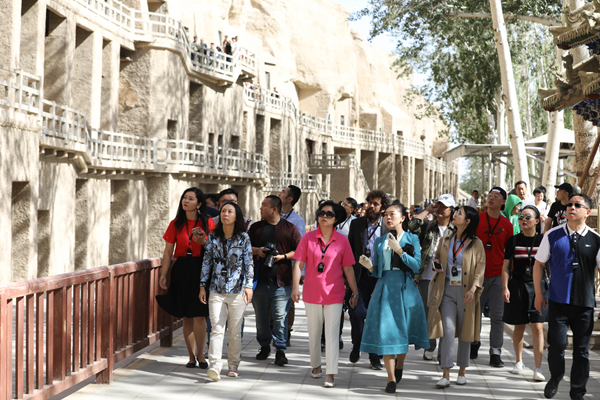
Summer vacation is the busiest time at the Mogao Grottoes in Dunhuang, Northwest China's Gansu province. A ticket reservation service and a cap on the number of visitors have been adopted to help preserve the murals. [Photo provided to China Daily]
Summer is the busiest season for staff at the Mogao Grottoes, as more than a third of the annual visitors to the UNESCO World Heritage site arrive during the vacation time.
Last year, the tourist attraction welcomed almost 2 million visitors.
Sitting in Dunhuang, Northwest China's Gansu Province, the Mogao Grottoes' 735 caves are home to a priceless collection of Buddhist artwork-more than 2,000 colored sculptures and 45,000 square meters of murals-all created by ancient worshippers.
However, visitors can only view about 110 of the caves.
"Too many visitors will affect the temperature, humidity and concentration of carbon dioxide in the cave, leading to repeated dissolution and crystallization of salt. This will cause the murals to decay," says Su Bomin, vice-president of the Dunhuang Academy, which manages the grottoes.
Therefore, multiple measures have been taken to preserve the paintings. In 2014, the academy opened a ticket reservation service and curbed the number of daily visitors. This summer, it has set a cap on the number of visitors every hour between 8 am and 3 pm, and no more than 12,000 tourists who have not booked tickets in advance are allowed to enter.
"The new measure has significantly lowered the capacity pressure at the site," says Li Ping, a member of the academy.
Scientific preservation
Over the years, countless antiquarians and experts have devoted their lives and careers to the protection and restoration of the cultural relics in a bid to delay their aging.
Li Yunhe, 86, has been repairing and restoring the ancient grottoes since the 1950s.
"I have repaired over 4,000 sq m of murals and more than 500 colored sculptures," says Li. "I have to keep updating my techniques to better restore the cultural relics."
A monitoring and early warning system also plays a key role in its conservation.

Summer vacation is the busiest time at the Mogao Grottoes in Dunhuang, Northwest China's Gansu province. A ticket reservation service and a cap on the number of visitors have been adopted to help preserve the murals. [Photo provided to China Daily]
The Mogao Grottoes began monitoring the nearby environment as early as the 1960s. In 1989, a meteorological station was set up and, in 2011, the current monitoring system was put into use.
Now the meteorological environment, cliff conditions, possible natural disasters such as floods and earthquakes as well as the interior environment of the caves are all under close surveillance, with the site closing to tourists once the temperature, humidity and carbon dioxide density threaten to exceed safe levels.
"All the data is automatically recorded every 15 minutes. We are studying the relationship between this data and the rate of the decay to continue exploring appropriate preventive measures," says Guo Qinglin, head of the academy's conservation institute.
In recent years, extreme weather has posed new threats to the grottoes. Rainfall recorded at the grottoes in July was the most since 1989, when the academy began tracking records of precipitation.
Thanks to a flood control project built in 2013, the downpours caused limited damage to the grottoes.
Digital push
Despite all the efforts of the academy, it is frustrating that these ancient grottoes will inevitably vanish some day.
However, the digitization of the Mogao Grottoes is currently underway, a project that will permanently preserve its glory.
By visiting the website Digital Dunhuang, visitors can immerse themselves in the images of more than 4,430 sq m of murals that span 30 caves.
The database is the result of more than three decades of work. In the 1980s, Dunhuang Academy China began partnering with research institutes and universities, including China's Zhejiang University and Northwestern University in the United States, to digitalize the ancient cultural relics.
At least 40,000 photos must be taken to digitalize a mural of 300 sq m. "Now we have collected the digital data of 180 plus caves," says Yu Tianxiu, who is leading the digitization work.
So far, the website has welcomed over 5 million visitors.
"We've tried many methods to bring the grottoes to life," says Fan Jinshi, honorary president of the academy. "We hope that the whole world will see the beauty of the Mogao Grottoes through Digital Dunhuang."

